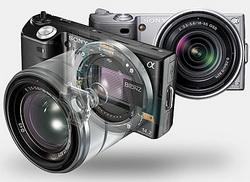The Mirrorless Camera Revolution
If you're shopping for a new camera these days, chances are you will run into a blizzard of acronyms you've never heard before ... MILC cameras, EVIL cameras, CSC cameras, DIL cameras, micro cameras. What is all this hooey? As confusing monikers go, DSLR is plenty bad enough. But true to the tradition of the Consumer Electronics industry, they've found a whole new way to befuddle the buyer. Welcome to the mirrorless camera revolution.
 Thankfully, other than the trip to acronym hell, there is good news here. These new generation MILC or EVIL or micro cameras shoot better pictures in a smaller size than anything we've seen before. Let's take a moment to sort it out...
Thankfully, other than the trip to acronym hell, there is good news here. These new generation MILC or EVIL or micro cameras shoot better pictures in a smaller size than anything we've seen before. Let's take a moment to sort it out...
Until recently, if you wanted a digital camera you had two choices. You could get a compact, pocket sized Point & Shoot, or you could get a big clunky DSLR. If you are all about convenience, the Point & Shoot pocket camera was the way to go. Point & Shoots certainly give you better picture quality than your cellphone, and they are easy to tuck away in a pocket or purse. The big problem with Point & Shoots is that the picture quality, while plenty fine for snapshots on Facebook, is not anywhere near good enough to satisfy serious photographers.
On the other hand, if you wanted great picture quality that rivals that of professional photographers, you had to get a bigger, bulkier, heavier DSLR (that stands for digital single lens reflex, which still doesn't tell you much). DSLR cameras look a lot like traditional 35mm film cameras. They have interchangeable lenses, much better optics, and they deliver top quality images. The big problem with DSLRs is that they're a nuisance to lug around and they cost a lot more than Point & Shoots.
Now, with the mirrorless camera revolution, you now have a third option. This new breed of cameras take pictures that rival the quality of many DSLRs, but they are smaller, lighter, and cheaper than the typical DSLR. So you no longer need to sacrifice picture quality for compact convenience.
Here's what the new mirrorless cameras are all about...
Look ma, no mirrors: You may know that on DSLR cameras, just like on the 35mm film cameras that they evolved from, there is a mirror inside that flips up and down and lets you see through the lens. You frame your picture by looking through an optical viewfinder that, thanks to the mirror, looks directly through the lens. Well, these new cameras eliminate the flipping mirror, which is a big reason why they are smaller.
The elimination of the mirror means that you must frame your picture by looking at an electronic image instead of seeing the actual scene through the lens with the optical viewfinder. You either sight the camera with an electronic viewfinder, or you use the LCD screen on the back, just like a Point & Shoot.
Since they eliminate the mirrors that exist in a DSLR, people instinctively call them mirrorless cameras. But to the purists among us, this term isn't exactly definitive since Point & Shoots don't have mirrors either.
Multiple Lenses: On a Point & Shoot compact camera you get one lens that is built into the unit. That can be a zoom lens with a huge range, but it is never great optical quality. Meanwhile, these new mirrorless cameras retain one of the key features of the DSLR, which is interchangeable lenses. The camera typically come packaged with a moderate range zoom lens, but each manufacturer gives you several zoom lenses to choose from. They also offer one or more fixed focal length, or prime, lenses within the system. Since this class of camera is new, the array of lenses currently available is not as extensive as you get with DSLRs. But we will be seeing more lenses released in a hurry as this segment of the camera market explodes. And, as an added bonus, some brands offer adapters that will allow you to use DSLR lenses with this new format.
Better picture quality than compact Point & Shoots: These new generation cameras have sensors that are larger than the sensors found in pocket cameras. The larger sensors and the superior optical quality of the lenses are two factors that contribute to their better picture quality. In fact, the sensors on some of these new mirrorless cameras are the same size as those found in many DSLRs. Smaller, Lighter than DSLRs: When fitted with the typical kit zoom lens that most of these cameras come with, they look like baby DSLRS. They are bigger than the pocket sized Point & Shoots, but not as bulky as many DSLRs. On the other hand, if you configure them with one of the thin format "pancake" prime lenses, they really are not too much bigger than a Point & Shoot at all.
The Identity Crisis
Here is the problem: These new cameras are different enough from Point & Shoots and DSLRs that nobody knows what to call them. Trying to pack this odd array of features into one acronym is tough. So the industry is flailing around, throwing a bunch of terms against the wall to see what sticks. Here are the latest attempts at a name for these things:
MILC -- Mirrorless Interchangeable Lens Compacts: Technically speaking, this is the most accurate descriptor anyone has come up with. Unfortunately it is painfully tedious, as bad as DSLR. And it has a good dash of the ludicrous mixed in; people will feel downright silly walking into a camera store and asking for a milk camera. Camera reviewers might like this term, but consumers will not.
EVIL cameras -- Electronic Viewfinder, Interchangeable Lens: The term EVIL camera became popular because it is funny and impossible to forget. In fact, you will forget what it stands for long before you ever forget the acronym. That is gold in the consumer marketplace. And people will walk into a camera store to ask for an evil camera, just for the reaction value. I've done it myself. You get odd looks.
There are two arguments against evil camera. One is technical, the other theological. Regarding the former, the camera nerds among us will say, "Well, now, these cameras may or may not have an electronic viewfinder; you can't call the LCD panel on the back a viewfinder." Actually, you can if you want to. But it is true that the definition of viewfinder is "a little hole in the camera that you hold up to your eye so you can see what the camera is looking at." And if we are going to stand on formalities, the live view LCD panels on the back do not qualify as electronic viewfinders.
Nevertheless, the term evil camera may stick around for a while. Who cares about the technicalities? People call them DSLRs without knowing what the acronym refers to, and the same can happen with evil cameras.
CSC cameras -- Compact System Cameras: This common term is popular because it is the least problematic of a lot of bad acronyms. In theory, the word "system" is supposed to tell you that the camera has a variety of lenses to go with it. But if you aren't into advanced photography you wouldn't know that, and you would need to know that to distinguish between compact system cameras and compact cameras, which are an entirely different thing.
As far as the word "compact" goes, they are indeed compact compared to DSLRs. But they are not as compact as the compact cameras we've been calling compacts for the last few years. So that term is somewhat misleading.
But beyond being confusing and misleading, the phrase Compact System Camera has a more serious problem: it has no sizzle, no personality-it is the sedan of camera names. And the acronym CSC is uninspiring and borderline meaningless. Who would walk into a retailer and say, "Please show me your CSCs"? Nope. Not gonna happen.
DIL cameras -- Digital Interchangeable Lens: Among the lamest of the acronyms yet. A DSLR is digital, and it has interchangeable lenses. So a DSLR is a DIL, so why call a mirrorless camera a DIL camera? Beyond that, Dil sounds dull. It is another one of those terms that a consumer will not use. People will say, "Honey, I'd like a new DSLR for my birthday." That works. But, "I'd like a new DIL for my birthday"? No way.
Micro cameras. This phrase is floating around on the Internet for some reason. I guess you could say "micro camera" has one HUGE advantage: it is not a ridiculous acronym; it is short, memorable and easy to say, which is something you can't say for the other options (except EVIL of course). And frankly, micro camera would be a terrific name for these things if only it weren't so absurdly erroneous. The English language is something we need to respect, and a micro camera must be smaller than a compact camera if we care anything about how our language works. There is nothing "micro" about these cameras at all-they are larger than Point & Shoot pocket compacts. A micro camera, as everyone knows, is one that is hidden in James Bond's cufflink.
Single-lens, Direct-view, SLD: Not sure where this one came from, but ... who's kidding whom here?
New Generation System Cameras. This is the phrase Olympus puts on their product packaging. Obviously the Olympus marketing folks are not enamored with the acronym soup the industry is swimming it. So this amorphous, friendly sounding phrase is a great way to avoid the problem entirely. And it would be fine, except that it has no meaning. Everything is new generation these days.
End of the Acronym Road
At the end of the day, the consumer is going to call these things mirrorless cameras. It is simple and easy to remember. It is not a bizarre acronym. And sales reps will know what you mean when you ask, "Where are your mirrorless cameras?" You won't feel funny saying it either. To the purist, we say yep, Point & Shoots are mirrorless cameras too. But nobody has ever called them that. They've already got too many names-compacts, pocket cameras, Point & Shoots-so they are at no risk of taking on another name. The term mirrorless camera is new, free of baggage, and plenty sufficient to distinguish these new models from DSLRs. Mirrorless is all we need to identify this new class of product.
So on 2CameraGuys.com, we may on occasion use the terms MILC cameras, or EVIL, or DIL, or even CSC, for readers who know these cameras by obscure geeky terms. But for the most part, we will avoid the crazy acronyms. We'll just call them mirrorless cameras, and trust you will know what we're talking about.










